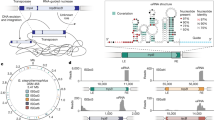Abstract
The 4,957-base pair (bp) transposon Tn3 encodes three polypeptides, two of which are needed for normal inter-replicon transposition and one, β-lactamase, which is responsible for the transposon's ampicillin resistance (Apr)1,2. The closely related transposon Tn1 specifies three interchangeable polypeptides of identical function. The 1,015-amino acid tnpA protein is essential for transposition, whereas the 185-residue tnpR protein regulates the rate of transposition3,4 and is required for the generation of normal end products of inter-replicon transposition5,6. Here we report the inter-replicon transposition properties of tnpA− tnpR− derivatives of both Tn1 and Tn3. We show that the tnpA product is sufficient to generate a transpositional co-integrate intermediate in which the donor and recipient replicons become fused between two directly repeated copies of the transposon. In the absence or presence of tnpA product, such co-integrates are efficiently converted to normal transposition end products in the presence of tnpR protein. Two amber mutants selected because of their derepressed tnpR-mediated control of transposition are also unable to resolve co-integrate intermediates in a Sup0 (suppressor minus) background. For each mutant, both mutant phenotypes are suppressed by SupD and SupE but not by SupF, confirming that the tnpR coding sequence specifies a single protein having both functions.
This is a preview of subscription content, access via your institution
Access options
Subscribe to this journal
Receive 51 print issues and online access
$199.00 per year
only $3.90 per issue
Buy this article
- Purchase on Springer Link
- Instant access to full article PDF
Prices may be subject to local taxes which are calculated during checkout
Similar content being viewed by others
References
Gill, R. E., Heffron, F. & Falkow, S. Nature 282, 797–801 (1979).
Heffron, F., McCarthy, B. J., Ohtsubo, H. & Ohtsubo, E. Cell 18, 1153–1163 (1979).
Chou, J., Casadaban, M. J., Lemaux, P. G. & Cohen, S. N. Proc. natn. Acad. Sci. U.S.A. 76, 4020–4024 (1979).
Chou, J., Lemaux, P. G., Casadaban, M. J. & Cohen, S. N. Nature 282, 801–806 (1979).
Arthur, A. & Sherratt, D. J Molec. gen. Genet. 175, 267–274 (1979).
Sherratt, D., Arthur, A. & Burke, M. Cold Spring Harb. Symp. quant. Biol. 45, 275–284 (1981).
Reed, R. R. Proc. natn. Acad. Sci. U.S.A. 78, 3428–3432 (1981).
Bolivar, F. Life Sci. 25, 807–817 (1979).
Chang, A. C. Y. & Cohen, S. N. J. Bact. 134, 1141–1156 (1978).
Datta, N. & Hedges, R. W. J. gen. Microbiol. 72, 349–355 (1972).
Gill, R., Heffron, F., Dougan, G. & Falkow, S. J. Bact. 136, 742–756 (1978).
Reed, R. R. Cell 25, 713–719 (1981).
Reed, R. R. & Grindley, N. D. F. Cell 25, 721–728 (1981).
Author information
Authors and Affiliations
Rights and permissions
About this article
Cite this article
Kitts, P., Lamond, A. & Sherratt, D. Inter-replicon transposition of Tn1/3 occurs in two sequential genetically separable steps. Nature 295, 626–628 (1982). https://doi.org/10.1038/295626a0
Received:
Accepted:
Issue Date:
DOI: https://doi.org/10.1038/295626a0
This article is cited by
-
Transposon Tn1 intra-molecular transposition
Molecular and General Genetics MGG (1984)
-
Fine structure of transposition genes of Tn2603 and complementation of its tnpA and tnpR mutations by related transposons
Molecular and General Genetics MGG (1983)
-
Nucleotide sequence of γδ resolvase gene and demonstration that its gene product acts as a repressor of transcription
Nature (1982)
Comments
By submitting a comment you agree to abide by our Terms and Community Guidelines. If you find something abusive or that does not comply with our terms or guidelines please flag it as inappropriate.



